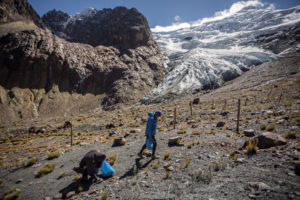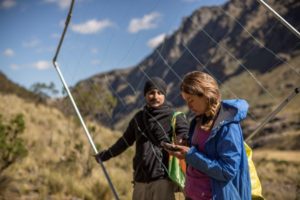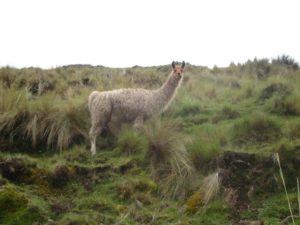26 December 2019
Llamas could help replenish plant life after glaciers retreat
Posted by Lauren Lipuma
Unexpected gardeners might help plant communities colonize newly exposed land
By Erin Malsbury

Zimmer compares sites at varying distances from glaciers in the Alps and the Andes. Credit: Anaïs Zimmer/University of Texas at Austin.
The rapid retreat of glaciers from alpine regions around the world could result in widespread ecosystem losses, according to new research. Now, scientists are exploring a hairy solution to this hairy problem in the form of llamas.
As glaciers retreat with increasing speeds, they leave behind bare swaths of land. But plants found downstream of glaciers will not necessarily be able to expand to fill the new space, resulting in less-diverse ecosystems that don’t provide crucial animal habitats or services like water cycling and slope stabilization.
Researchers at the University of Texas at Austin are studying these post-glacier landscapes in the Andes and the Alps to predict how ecosystems in areas adjacent to glaciers will change in the coming decades and to find ways to minimize habitat losses. Glacial melt supplies water to downstream environments—wetlands, grasslands and forests—which store carbon and stabilize mountain slopes.
“Mountain communities depend on glaciers,” said Anaïs Zimmer, a graduate student at UT Austin who presented the work this week at AGU’s Fall Meeting in San Francisco. “So what will we do when we don’t have glaciers?”

Plot used to sample landscapes in the Andes and the Alps. Credit: Anaïs Zimmer/University of Texas at Austin.
To begin addressing that question and to better understand how and when ecosystems form on bare, “almost sterile emerging terrain,” Zimmer spent months high in the Andes and the Alps surveying moraines that were recently covered by glaciers. She compared soil samples and plant community characteristics, such as the number of species per plot and the percentage of the ground covered by vegetation at sites located different distances from the glaciers that had been exposed for anywhere from a few months to 38 years.
New plant communities generally sprout up quickly, she found. “It’s amazing how nature has this power to colonize,” Zimmer said.
But the flora isn’t fast enough to keep pace with the rapid disappearance of glaciers. In particular, plants that rely on animals to spread their seeds find it increasingly difficult to establish themselves on land left behind by glaciers. As the ice retreats to higher elevations, fewer animals venture to the frigid and dry landscapes. Some plants that bordered glaciers at lower elevations can no longer migrate upwards at all, such as species of the flowering, grass-like Rush family found in Andean wetlands.
As a result, the Andes risk losing regular water cycles, and in the Alps, the loss of glaciers threatens the stability of mountain slopes.
To explore land-management options that could help spread diverse, healthy ecosystems in the Andes, Zimmer is now turning to an unusual strategy: llamas.
Llamas are one of the few animals that traverse the rocky, high-altitude post-glacial landscapes. These alpine grazers could help plant communities take root on new ground faster by providing fertilizer, dispersing seeds through waste, and breaking up cryptogamic crust, a layer of cyanobacteria, moss and lichen that forms over bare ground and can prevent new plants from taking root. Wild goats in the Alps could potentially offer some of the same benefits. Zimmer’s current research compares the success of plant colonization at post-glacier sites with and without llamas.
As climate change continues to accelerate the retreat of glaciers, the lag in plant colonization will continue to increase. Understanding how ecosystems respond to the disappearance of nearby glaciers is crucial for preserving habitats and ecosystem services around the world. “We don’t have to find solutions for what’s happening now,” Zimmer said. “We have to find solutions for what’s happening in the future.”
Erin Malsbury is a current graduate student in the UC Santa Cruz Science Communication program.




 GeoSpace is a blog on Earth and space science, managed by AGU’s Public Information staff. The blog features posts by AGU writers and guest contributors on all sorts of relevant science topics, but with a focus on new research and geo and space sciences-related stories that are currently in the news.
GeoSpace is a blog on Earth and space science, managed by AGU’s Public Information staff. The blog features posts by AGU writers and guest contributors on all sorts of relevant science topics, but with a focus on new research and geo and space sciences-related stories that are currently in the news.
Anais Zimmer’s work is a brilliant interface of ecology, soils, and spatial human landscape interaction, aka excellent geographic science!
This is a very interesting article about the weather changes in The mountains of Peru and the World.
Thank you for your publication this article and referring the lamas influence for adapter the vegetation in the areas on the glaciers going out.
Our organization participating in this project.
Twenty years ago we bild a innovative project whit lamas for reintroduce this cammeles in the National Huascaran Park, whit the objective to realice Llama Trek in the Pre Inca Ancient trail from Olleros to Chavin de Huantar.
Now our lamas participing in this transcend research of Anais Zimmer.